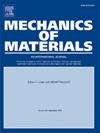A comprehensive study on the effectiveness of the stress and damage model parameters in predicting the compression fracture behavior of selective laser melted AlSi10Mg BCC lattices
IF 3.4
3区 材料科学
Q2 MATERIALS SCIENCE, MULTIDISCIPLINARY
引用次数: 0
Abstract
The Johnson and Cook (JC) stress and damage model parameters determined from the machined bulk cylindrical specimens and as-built struts through tension and compression tests were used to model quasi-static compression behavior of selective laser melt-fabricated AlSi10Mg alloy lattices. The lattices had the same cell size (10 mm) and strut diameter (1 mm), but different number of cells (2 × 2 × 2, 10 × 10 × 2 and 5 × 5 × 5) and geometries (sandwich and cubic). Four different sets of JC damage model parameters (brittle and ductile notch-insensitive and compression and tension notch-sensitive) were further implemented in the lattice compression numerical models. The brittle damage model parameters and smaller mesh sizes resulted in cracking the face-sheet corner strut nodes before the occurrence of a bending-dominated initial peak stress. The notch-sensitive damage model parameters exhibited no bent-strut fracture in the middle layers of the lattices and increased the crack initiation strains as compared with the notch-insensitive damage model parameters. Despite significant variations in the initial peak stresses of the tested 2 × 2 × 2 and 10 × 10 × 2 lattices, the implication of the strut micro-tension stress model together with the compression notch-sensitive damage model parameters using 0.25 mm mesh size conservatively approximated the experimental deformation stresses while the machined bulk specimen tension-stress model over predicted the experimental stresses. On the other side, the strut stress model with 0.15 mm mesh size accurately predicted the experimental diagonal shear/fracture mode of struts with a slightly higher numerical initial peak stress. The compression tests on the strut specimens extracted from the as-built lattices yielded similar stress model parameters with the micro-tension tests. The differences between the initial peak stresses of the investigated sandwich and cubic lattices were further explained by the differences in the lattice boundary conditions.
综合研究了应力和损伤模型参数在预测选择性激光熔化AlSi10Mg BCC晶格压缩断裂行为中的有效性
采用Johnson和Cook (JC)的应力和损伤模型参数,通过拉伸和压缩试验确定了加工后的圆柱形体试件和已建支撑的应力和损伤模型参数,模拟了选择性激光熔制AlSi10Mg合金晶格的准静态压缩行为。格子尺寸(10 mm)和支撑直径(1 mm)相同,但格子数量(2 × 2 × 2、10 × 10 × 2和5 × 5 × 5)和几何形状(夹心和立方)不同。在点阵压缩数值模型中进一步实现了四组不同的JC损伤模型参数(脆性和韧性缺口不敏感以及压缩和张力缺口敏感)。脆性损伤模型参数和较小的网格尺寸导致面板角杆节点在弯曲主导的初始峰值应力出现之前发生开裂。与缺口不敏感损伤模型参数相比,缺口敏感损伤模型参数在晶格中间层没有出现弯曲-支撑断裂,并且裂纹起裂应变增加。尽管测试的2 × 2 × 2和10 × 10 × 2晶格的初始峰值应力存在显著差异,但采用0.25 mm网格尺寸的支撑微拉应力模型和压缩缺口敏感损伤模型参数的暗示保守地逼近了实验变形应力,而加工体试件的拉应力模型则超过了实验应力的预测。另一方面,0.15 mm网格尺寸的支撑应力模型准确地预测了支撑的实验斜剪/断裂模式,数值初始峰值应力略高。对从已建网格中提取的支撑试件进行压缩试验,得到的应力模型参数与微拉伸试验相似。晶格边界条件的差异进一步解释了夹层结构与立方晶格的初始峰值应力差异。
本文章由计算机程序翻译,如有差异,请以英文原文为准。
求助全文
约1分钟内获得全文
求助全文
来源期刊

Mechanics of Materials
工程技术-材料科学:综合
CiteScore
7.60
自引率
5.10%
发文量
243
审稿时长
46 days
期刊介绍:
Mechanics of Materials is a forum for original scientific research on the flow, fracture, and general constitutive behavior of geophysical, geotechnical and technological materials, with balanced coverage of advanced technological and natural materials, with balanced coverage of theoretical, experimental, and field investigations. Of special concern are macroscopic predictions based on microscopic models, identification of microscopic structures from limited overall macroscopic data, experimental and field results that lead to fundamental understanding of the behavior of materials, and coordinated experimental and analytical investigations that culminate in theories with predictive quality.
 求助内容:
求助内容: 应助结果提醒方式:
应助结果提醒方式:


